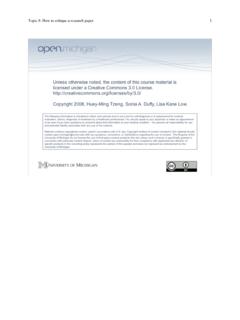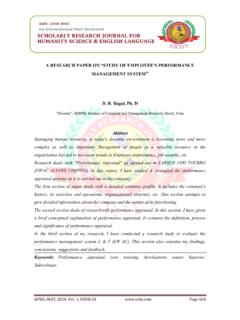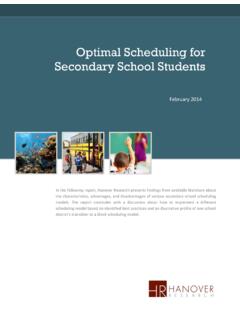Transcription of Secondary Research - SAGE Publications Inc
1 3 Secondary ResearchSecondary market Research refers to any data gathered for one pur-pose by one party and then put to a second use by or made to servethe purpose of a second party. Secondary market Research is thus thebroadest and most diffuse tool within the toolbox, because it includesvirtually any information that can be reused within a market researchcontext. Secondary Research is also the closest thing to an all-purposemarket Research tool, because virtually every project makes some use ofsecondary data and almost any decision stage may incorporate somekind of Secondary Research .
2 As a general rule, relatively speakingsecondary Research also is the cheapest and quickest form of marketresearch. You ignore or skimp on it at your peril. Its range of applica-tion is limited only by your is helpful to distinguish between internal and external secondaryresearch. Internal Secondary data consist of information gathered else-where within your firm. The major categories include (1) sales reports,(2) customer databases, and (3) reports from past primary marketresearch. Sales reports generally give data broken down by product cat-egory, region, and time period.
3 More sophisticated systems also givebreakdowns by distribution channel, level of price discount, customertype (large, medium, small), and similar categories. Customer databasesmight include a recording of brief descriptive data on all accounts(industry, contact person, phone number, purchase history); a log oftech support or response center calls; a record of specific products pur-chased; and the like. Records of past primary market Research includeresults of surveys and focus groups conducted in prior years, accumu-lated customer visit trip reports, and so 3/23/2005 7:44 PM Page 53 External Secondary Research includes (1) information gathered bygovernment agencies such as the Census Bureau, (2) information com-piled for sale by commercial vendors, and (3) various kinds of publicand quasi-public information available from diverse sources.
4 Govern-ment agencies collect an enormous amount of demographic ( , theCensus Bureau) and economic trend data ( , federal and state depart-ments of commerce). In recent years the United States government hasalso done more to help companies seeking to export by providing infor-mation on overseas markets. Entire volumes are devoted to simply list-ing and cross-referencing various government important kind of Secondary data available from commercialvendors is known as the syndicated report. For a syndicated report ananalyst compiles a variety of data, using libraries, databases, phone calls,and even some primary market Research such as interviews or surveys,in order to address a topic such as trends in the in-home computer net-working market, 2005 2008.
5 The goal is to sell the report to as manynetwork equipment companies as can be persuaded to buy. Syndicatedreports may be one-time efforts or may appear periodically. Because theappetite for data is so huge, especially in technology markets, a wholeindustry of syndicated report vendors has grown up to satisfy thisappetite. These commercial vendors function as one part librarian, onepart statistician, one part detective, and one part proxy market employ analysts who are in the business of being industry experts,and a certain number of hours of these analysts time can be purchasedalong with the vendor s and quasi-public data sources include anything published ina magazine or newspaper.
6 Most industries have a few trade magazinesdevoted to coverage of companies, events, and trends. A few industries,like the computer and telecommunications industries, are the focus ofa slew of Publications . Similarly, most industries of note are, on occa-sion, the subject of a feature article in the Wall Street Journal, New YorkTimes, Los Angeles Times,or other respected newspaper. Trade associa-tions, university survey Research centers, nonprofit agencies, and otherspublish data from time to time. With the spread of computerized infor-mation retrieval services (everything from the traditional Dialog to theWeb) it has become easier to bring together data from a wide range ofsources and THE MARKET Research 3/23/2005 7:44 PM Page 54 ProcedureThree types of procedure are relevant here: (1) steps to be taken at thefirm level, to facilitate the collection and use of Secondary researchthroughout the firm.
7 (2) steps to be taken by individuals within a firmin connection with either a market Research projector as part ofongoingmarket intelligenceefforts. The logic of the first distinction is that anindividual contributor or manager will find it difficult to do excellentsecondary Research unless an infrastructure has already been put inplace at the firm level. The logic of the second distinction is based onthe difference between a market Research study and ongoing marketintelligence gathering, as set out in Chapter 1, and the differing demandsthese place on Secondary Research .
8 A discipline common to almost alluses of Secondary data is search, and Appendix 3A addresses to Be Taken by the the corporate major corporations havehad internal libraries for many years, of late the demands on and thepotential benefits from these libraries have rapidly escalated. Today inthe marketing area the primary holding is not books or even periodicalsbut the syndicated reports bought from various vendors. Because somany individuals have a use for particular reports on occasion, mostcorporations of any size centralize the purchase of market researchreports, and have the collection maintained by either a division of thelibrary or a department within the market Research carefully thought-out strategy of which reports to buy fromwhich vendors is a must.
9 It may be quite difficult for an individual pro-ject manager to get the funds or find the time to locate a valuable reportthat is not part of the collection if he or she even learns of its existenceat all. Hence, the best way to promote the use of Secondary data is toarrange to have on hand most of the most useful good library has an effective indexing and cataloguing strategy sothat relevant data can be easily located. A good library will also be onSecondary Research 3/23/2005 7:44 PM Page 55the lookout for specialized resources services that compile statistics,bulletins that bring together articles from a variety of trade publica-tions, and so forth.
10 Finally, a good library keeps up with new technol-ogy for collecting and distributing information, such as electronicclipping services, wherein a semi-intelligent agent searches for articlesmeeting a profile set up by a user. Phrases like the Information Societyand the Data Explosion are not hype when it comes to Secondary s a full-time job keeping up with the proliferation of sources of secon-dary data, and successful firms hire librarians or outsource to consul-tants who can do appropriate consultation located in themarket Research area or the corporate library, one or more persons haveto serve as reference librarians who can proactively help a manager findrelevant resources rather than simply responding to queries.

















